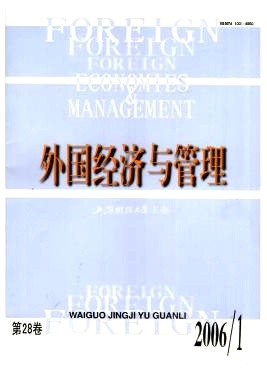从消费文化的变迁看后现代营销的整合
外国经济与管理 2006 年 第 28 卷第 01 期, 页码:46 - 53
摘要
参考文献
摘要
随着后现代消费文化的形成和发展,许多传统的营销范式与技术正在失去其原有的效力。本文采用一种文化分析方法,通过对消费文化的考察,识别和区分了集中体现后现代消费文化特点的几种具体、典型的后现代消费形态和模式,并在此基础上提出了后现代营销所需要的各种整合。
[1]R Barthes.Mythologies[M].London:Cape,1972.
[2]A F Firat and A Venkatesh.Liberatory postmodernism and the reenchantment of consumption[J].Journal of ConsumerResearch,1995,22:239-267.
[3]D B Holt.Why do brands cause trouble?a dialectical theory of consumer culture and branding[J].Journal of ConsumerResearch,2002,(Jun.):1-64.
[4]S Brown.Postmodern marketing[M].London:Routledge,1995:2.
[5]R V Kozinets and J M Handelman.Ensouling consumption:a netnographic exploration of boycotting behavior[J].Ad-vances in Consumer Research,1998,25:475-480.
[6]G Debord.Society of the spectacle[M].Detroit:Black&Red,1983.
[7]J Baudrillard.Simulations[M].New York:Semiotexte,1983:148.
[8]B Cova.The postmodern explained to managers:implications for marketing[J].Business Horizons,1996,(Nov./Dec.):15-23.
[9]M Douglas and B Isherwood.The World of goods[M].New York:Norton,1979.
[10]A F Firat.The consumer in postmodernity[J].Advances in Consumer Research,1991,18:70-76.
[11]A F Firat and A Venkatesh.Postmodernity:the age of marketing[J].International Journal of Research in Marketing,1993,10(3):227-249.
[12]A F Firat and C J ShultzⅡ.From segmentation to fragmentation markets and marketing strategy in the postmodern era[J].European Journal of Marketing,1997,31(3/4):183-207.
[13]B Cova.Community and consumption towards a definition of the“linking value”of product or services[J].EuropeanJournal of Marketing,1997,31(3/4):297-316.
[14]B Cova and V Cova.Tribal marketing:the tribalisation of society and its impact on the conduct of marketing[J].Euro-pean Journal of Marketing,2002,(S.I.):1-23.
[15]R Elliott.Symbolic meaning and postmodern consumer culture[A].In D Brownlie,M Saren,R Wensley,and R Whit-tington(ed.).Rethinking marketing:towards critical marketing accountings[C].London:Sage,1999:111-125.
[16]M Poster.Translator’s introduction[A].In Jean Baudrillard(ed.).The mirror of production[C].St.Louis:Telos,1975:1-15.
[17]R Elliott and K Wattanasuwan.Brands as symbolic resources for the construction of identity[J].International Journalof Advertising,1998,17(2):131-144.
[18]王长征,周玲.面向“联系价值”的后现代部落营销[J].外国经济与管理,2005,(27)2:51-58.
[19]D Harvey.The Condition of modernity:an inquiry into the origin of cultural change[M].Cambridge,MA:Blackwell,1989.
[20][英]卡蒙.李.市场营销的文化因素[A].迈克尔.J.贝克.市场营销百科[C].沈阳:辽宁教育出版社,1998:76-83.
①本文所使用的“文化”是一个狭义的概念,它只涉及人类的精神和情感活动,特别是与人类的信念和价值观有关的方面。有关“消费文化”的概念和内涵,可以参见卢瑞(2003)。
②现有文献中有多个相关或类似的概念,其中最常见的是符号消费、象征消费、形象消费等,它们都是与产品(物)消费相对应的概念,主要是指对象征意义的消费,即把商品(包括产品和服务)消费都当作象征或符号的消费。
③“后现代性”(postmodernity)是与“现代性”(modernity)对应的一个概念,本文主要是在历史时期的概念上使用这两个术语(参见费瑟斯通,2000)。
④现代之前的享乐主义追求的是感官体验,即注重感觉,满足感官享受;而现代享乐主义则倾向于在幻想中追求快乐的体验,它已不再与感官享受和生理满足发生联系,并且也是一种情感受到控制的体验(参见卢瑞,2003)。
⑤在菲拉特和万卡塔什等人之前,这些所谓的“后现代状况”就已是其他学科领域的后现代主义者广泛讨论的主题。菲拉特和万卡塔什等人也经常在“后现代状况”、“后现代的文化状况”、“后现代主义”等不同的概念下讨论这些相同的主题。
⑥正是这两种文化价值取向的并存,才导致许多研究者观察到“个性消费”,以及相对较小的研究者社区观察到了“部落消费”。在这一意义上,个性消费和部落消费也可以看作是后现代消费文化的另外两种基本表现形态。
⑦但哈雷俱乐部的成功并不仅仅源自于一对一营销和部落营销的整合,它实际上可以被看作是本文所讨论的所有营销概念整合运用的结果。可以参见卡蒙.李(1998)的有关讨论。
[2]A F Firat and A Venkatesh.Liberatory postmodernism and the reenchantment of consumption[J].Journal of ConsumerResearch,1995,22:239-267.
[3]D B Holt.Why do brands cause trouble?a dialectical theory of consumer culture and branding[J].Journal of ConsumerResearch,2002,(Jun.):1-64.
[4]S Brown.Postmodern marketing[M].London:Routledge,1995:2.
[5]R V Kozinets and J M Handelman.Ensouling consumption:a netnographic exploration of boycotting behavior[J].Ad-vances in Consumer Research,1998,25:475-480.
[6]G Debord.Society of the spectacle[M].Detroit:Black&Red,1983.
[7]J Baudrillard.Simulations[M].New York:Semiotexte,1983:148.
[8]B Cova.The postmodern explained to managers:implications for marketing[J].Business Horizons,1996,(Nov./Dec.):15-23.
[9]M Douglas and B Isherwood.The World of goods[M].New York:Norton,1979.
[10]A F Firat.The consumer in postmodernity[J].Advances in Consumer Research,1991,18:70-76.
[11]A F Firat and A Venkatesh.Postmodernity:the age of marketing[J].International Journal of Research in Marketing,1993,10(3):227-249.
[12]A F Firat and C J ShultzⅡ.From segmentation to fragmentation markets and marketing strategy in the postmodern era[J].European Journal of Marketing,1997,31(3/4):183-207.
[13]B Cova.Community and consumption towards a definition of the“linking value”of product or services[J].EuropeanJournal of Marketing,1997,31(3/4):297-316.
[14]B Cova and V Cova.Tribal marketing:the tribalisation of society and its impact on the conduct of marketing[J].Euro-pean Journal of Marketing,2002,(S.I.):1-23.
[15]R Elliott.Symbolic meaning and postmodern consumer culture[A].In D Brownlie,M Saren,R Wensley,and R Whit-tington(ed.).Rethinking marketing:towards critical marketing accountings[C].London:Sage,1999:111-125.
[16]M Poster.Translator’s introduction[A].In Jean Baudrillard(ed.).The mirror of production[C].St.Louis:Telos,1975:1-15.
[17]R Elliott and K Wattanasuwan.Brands as symbolic resources for the construction of identity[J].International Journalof Advertising,1998,17(2):131-144.
[18]王长征,周玲.面向“联系价值”的后现代部落营销[J].外国经济与管理,2005,(27)2:51-58.
[19]D Harvey.The Condition of modernity:an inquiry into the origin of cultural change[M].Cambridge,MA:Blackwell,1989.
[20][英]卡蒙.李.市场营销的文化因素[A].迈克尔.J.贝克.市场营销百科[C].沈阳:辽宁教育出版社,1998:76-83.
①本文所使用的“文化”是一个狭义的概念,它只涉及人类的精神和情感活动,特别是与人类的信念和价值观有关的方面。有关“消费文化”的概念和内涵,可以参见卢瑞(2003)。
②现有文献中有多个相关或类似的概念,其中最常见的是符号消费、象征消费、形象消费等,它们都是与产品(物)消费相对应的概念,主要是指对象征意义的消费,即把商品(包括产品和服务)消费都当作象征或符号的消费。
③“后现代性”(postmodernity)是与“现代性”(modernity)对应的一个概念,本文主要是在历史时期的概念上使用这两个术语(参见费瑟斯通,2000)。
④现代之前的享乐主义追求的是感官体验,即注重感觉,满足感官享受;而现代享乐主义则倾向于在幻想中追求快乐的体验,它已不再与感官享受和生理满足发生联系,并且也是一种情感受到控制的体验(参见卢瑞,2003)。
⑤在菲拉特和万卡塔什等人之前,这些所谓的“后现代状况”就已是其他学科领域的后现代主义者广泛讨论的主题。菲拉特和万卡塔什等人也经常在“后现代状况”、“后现代的文化状况”、“后现代主义”等不同的概念下讨论这些相同的主题。
⑥正是这两种文化价值取向的并存,才导致许多研究者观察到“个性消费”,以及相对较小的研究者社区观察到了“部落消费”。在这一意义上,个性消费和部落消费也可以看作是后现代消费文化的另外两种基本表现形态。
⑦但哈雷俱乐部的成功并不仅仅源自于一对一营销和部落营销的整合,它实际上可以被看作是本文所讨论的所有营销概念整合运用的结果。可以参见卡蒙.李(1998)的有关讨论。
引用本文
王长征. 从消费文化的变迁看后现代营销的整合[J]. 外国经济与管理, 2006, 28(1): 46–53.
导出参考文献,格式为:
上一篇:组织认同理论研究述评
下一篇:论消费者行为研究范式的转向





 5445
5445  0
0

